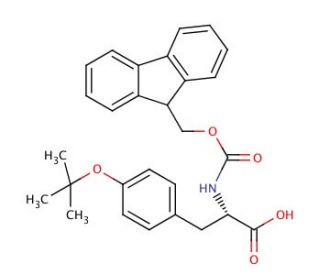

Molecular structure of Fmoc-Tyr(tBu)-OH, CAS Number: 71989-38-3
Fmoc-Tyr(tBu)-OH (CAS 71989-38-3)
Alternate Names:
N-(9-Fluorenylmethoxycarbonyl)-O-tert-butyl-L-tyrosine
Application:
Fmoc-Tyr(tBu)-OH is an Fmoc protected tyrosine derivative
CAS Number:
71989-38-3
Molecular Weight:
459.53
Molecular Formula:
C28H29NO5
For Research Use Only. Not Intended for Diagnostic or Therapeutic Use.
* Refer to Certificate of Analysis for lot specific data.
QUICK LINKS
Ordering Information
Description
Technical Information
Safety Information
SDS & Certificate of Analysis
Fmoc-Tyr(tBu)-OH is a derivative of tyrosine, an amino acid found in proteins. It is a building block for peptide synthesis in biochemistry and molecular biology. The Fmoc (9-fluorenylmethoxycarbonyl) group is used as a protecting group for the amino terminus of peptides, allowing for stepwise assembly of peptide chains. Fmoc-Tyr(tBu)-OH is useful in the field of peptide chemistry, allowing for the synthesis of complex peptides and proteins for research purposes.
Fmoc-Tyr(tBu)-OH (CAS 71989-38-3) References
- Aza-Amino Acids Disrupt β-Sheet Secondary Structures. | McMechen, MA., et al. 2019. Molecules. 24: PMID: 31109055
- Insulin Hot-Spot Analogs Formed with N-Methylated Amino Acid Residues Inhibit Aggregation of Native Hormone. | Swiontek, M., et al. 2019. Molecules. 24: PMID: 31618999
- Peptide Probes with Aromatic Residues Tyr and Phe at the X Position Show High Specificity for Targeting Denatured Collagen in Tissues. | Wei, W., et al. 2020. ACS Omega. 5: 33075-33082. PMID: 33403269
- An Engineered Arginine Residue of Unusual pH-Sensitive Reactivity Facilitates Site-Selective Antibody Conjugation. | Nilchan, N., et al. 2021. Biochemistry. 60: 1080-1087. PMID: 33754696
- Screening of Self-Assembling of Collagen IV Fragments into Stable Structures Potentially Useful in Regenerative Medicine. | Kolasa, M., et al. 2021. Int J Mol Sci. 22: PMID: 34948383
- Optimized Fmoc-Removal Strategy to Suppress the Traceless and Conventional Diketopiperazine Formation in Solid-Phase Peptide Synthesis. | Yang, Y. and Hansen, L. 2022. ACS Omega. 7: 12015-12020. PMID: 35449974
- Optimization of Peptide Linker-Based Fluorescent Ligands for the Histamine H1 Receptor. | Kok, ZY., et al. 2022. J Med Chem. 65: 8258-8288. PMID: 35734860
- Peptidomimetic Small-Molecule Inhibitors of 3CLPro Activity and Spike-ACE2 Interaction: Toward Dual-Action Molecules against Coronavirus Infections. | Tedesco, F., et al. 2022. J Org Chem. 87: 12041-12051. PMID: 36039955
- Neurotensin analogs by fluoroglycosylation at Nω-carbamoylated arginines for PET imaging of NTS1-positive tumors. | Schindler, L., et al. 2022. Sci Rep. 12: 15028. PMID: 36056076
- Solid-phase synthesis and pathological evaluation of pyroglutamate amyloid-β3-42 peptide. | Cho, I., et al. 2023. Sci Rep. 13: 505. PMID: 36627316
- Dipropylamine for 9-Fluorenylmethyloxycarbonyl (Fmoc) Deprotection with Reduced Aspartimide Formation in Solid-Phase Peptide Synthesis. | Personne, H., et al. 2023. ACS Omega. 8: 5050-5056. PMID: 36777595
- Synthesis of Polysubstituted Pyridines and Pyrazines via Truce-Smiles Rearrangement of Amino Acid-Based 4-Nitrobenzenesulfonamides. | Tkadlecová, M., et al. 2023. J Org Chem. 88: 3228-3237. PMID: 36797215
- Synthesis and radiolabelling of PSMA-targeted derivatives containing GYK/MVK cleavable linkers. | Murce, E., et al. 2023. R Soc Open Sci. 10: 220950. PMID: 36908985
- Tripeptides conjugated with thiosemicarbazones: new inhibitors of tyrosinase for cosmeceutical use. | Ledwoń, P., et al. 2023. J Enzyme Inhib Med Chem. 38: 2193676. PMID: 37146256
- Novel Polymyxin-Inspired Peptidomimetics Targeting the SARS-CoV-2 Spike:hACE2 Interface. | Bugatti, K., et al. 2023. Int J Mol Sci. 24: PMID: 37240111
Ordering Information
| Product Name | Catalog # | UNIT | Price | Qty | FAVORITES | |
Fmoc-Tyr(tBu)-OH, 10 g | sc-250020 | 10 g | $42.00 |
